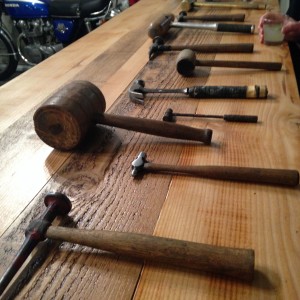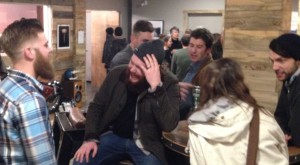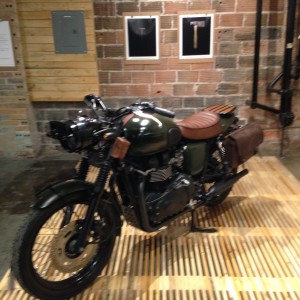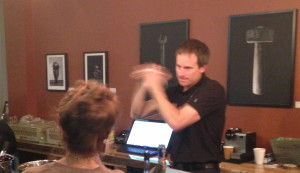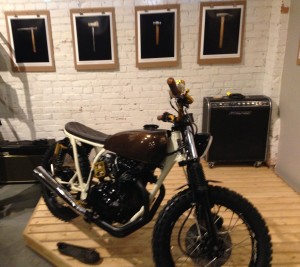 Several weeks ago I went to a photography exhibit consisting solely of photographs of hammers. Heavy hammers, dainty hammers, wooden hammers, tarnished old hammers, shiny new hammers. Hammers. I suppose one reason it’s taken me so long to blog about this for class is because it’s quite a stretch, mounting an exhibit consisting solely of photographs of hammers. So much so that writing a blog dedicated to an exhibit consisting solely of photographs of hammers seems like it would be pounding the whole notion into a pulpy mess.
Several weeks ago I went to a photography exhibit consisting solely of photographs of hammers. Heavy hammers, dainty hammers, wooden hammers, tarnished old hammers, shiny new hammers. Hammers. I suppose one reason it’s taken me so long to blog about this for class is because it’s quite a stretch, mounting an exhibit consisting solely of photographs of hammers. So much so that writing a blog dedicated to an exhibit consisting solely of photographs of hammers seems like it would be pounding the whole notion into a pulpy mess.
“I inherited a box that belonged to my Grandfather. Inside were 3 hammers.”
So ran the photographer/curator spiel at the entrance to the exhibit. “The hammer is the earliest and most simple of all tools know [sic] to humanity. It, more than any other tool, appears in folklore, mythology, and legend, representing the strength and endurance of man. It is . . . the only tool designed to both create and destroy. . . . . These images take the hammers away from their normal environments and by doing so let them tell their story.”
The photography exhibit was hosted at a hipster motorcycling shop called MotoVida that’s opened up in the North End offering customs builds, parts, and apparel. The shop’s website even includes a “Manifesto.” The space itself is done up with exposed pipes, distressed wood, and old brick of the sort that leads to assumptions (false ones) that something spelt is being baked nearby in a woodfire oven. I’m not trying deride the shop or the photography exhibit so much as I am the fact that I myself went to a hipster, hammer-photography event held at a motorcycle shop. It was the kind of thing where if you arrived on foot wearing a dress but no beard, no plaid, no toque, no baseball cap facing in the wrong direction, people assumed you’d stumbled through the wrong door hoping to order an Americano. I was only there for the cocktails. And for this blog.
A friend and I wandered the room with our raspberry martinis and Moscow Mules, feeling unmanly and looking studiously at the hammer pictures. They were beautifully photographed, it must be said, both in colour and black and white, sharply focused and artfully lit. In the images, the dents and chipped paint, the patches of rust were so clearly rendered you felt you could reach out and pluck them from the wall, feel their heft, take a swing at something.
No need for that, however, because the hammers themselves, or a selection of them were also in attendance, sprawled across a bar-top at the back, magnetic, hands twitching across the room towards them. The bar-top was like the touch-pond at the aquarium. Oooh, can I? Oh! Feel that!
Actually I’m not sure we were even supposed to handle the hammers, but why else would they be lying there if not for the many huge men with thick beards to hoist them in their large hands and imagine what could be built or demolished by them. The cocktails were sinking in by then. Look at all these hearty homesteaders! I thought, gazing blearily at the haze of plaid and tools. What are we all doing here? Are we barn-raising?
A better question – am I moved or enlightened in any way by hammers as art? I don’t think so. Encircled by hammers, no matter how artfully displayed, it’s easy to slide from thoughts of their utility to discomfort over their lethality. That’s not the hammer’s fault. For a moment, surrounded by burly men and swaying tipsy in front of a skinny, needle-headed hammer, I thought of pit bull terriers and how they are, in their panting hearts, faithful and obedient creatures, but so often used for ill. And more often than not, by men.
My own father is a giant, a gentle one. Smooth-shaven, he did for a time collect antique tools and hang them on the wall of his living room until he remarried and acquired a parrot whose cage now hangs in the tool corner. I was always less interested in the tools themselves than in the idea of my father visiting markets and antique stores around the globe, seeking out rusted and functional things, chatting up the person selling them to get to the bottom of what an earth they were used for.
His own workshop occupies the ground floor of his home. As a child, I had free reign over the tools and materials, cobbling together unsupervised projects and contraptions that would today, in these coddled times, trigger calls by the neighbours to Child Protection Services.
My dad would stop by occasionally to inspect my inventions. Once, he caught me with my little hand choked high on the throat of the hammer pecking ineffectually at a nail.
“Like this,” I remember him saying, laying his hand over my own and sliding my grip down the handle and into the proper position. “No daughter of mine will grow up not knowing how to use a hammer.”
FWIW: I’m back at school, taking a course requiring me to write a weekly-ish blog, sometimes about the works we’re reading in class, sometimes about new encounters or experiences, particularly those that involve other art forms. Class blogs are here, here, here, here, and here. If these posts seem different from those in the past, this is why.
